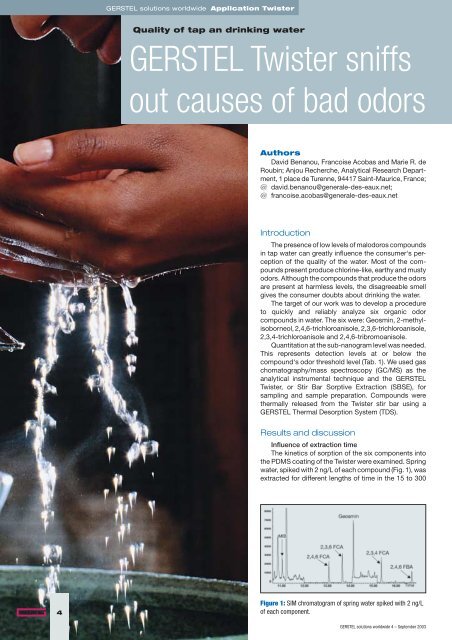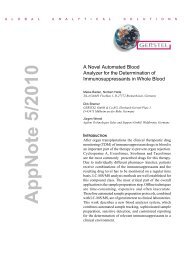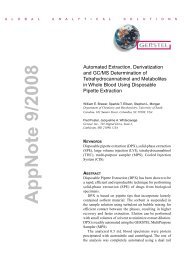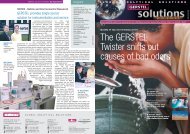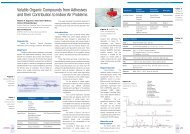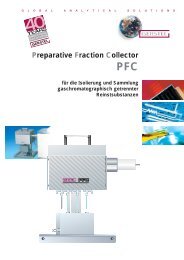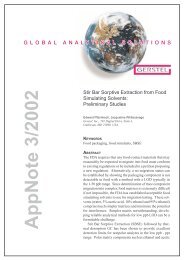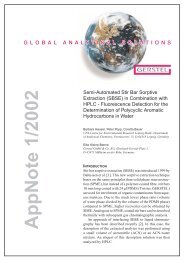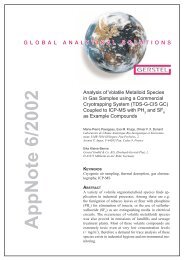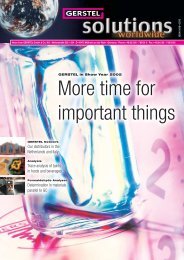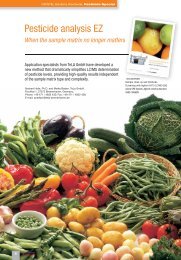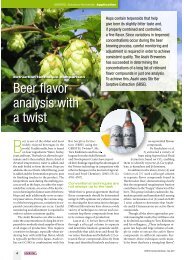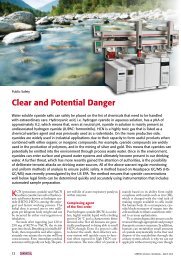GERSTEL Twister sniffs out causes of bad odors
GERSTEL Twister sniffs out causes of bad odors
GERSTEL Twister sniffs out causes of bad odors
You also want an ePaper? Increase the reach of your titles
YUMPU automatically turns print PDFs into web optimized ePapers that Google loves.
<strong>GERSTEL</strong> solutions worldwide Application <strong>Twister</strong><br />
Quality <strong>of</strong> tap an drinking water<br />
<strong>GERSTEL</strong> <strong>Twister</strong> <strong>sniffs</strong><br />
<strong>out</strong> <strong>causes</strong> <strong>of</strong> <strong>bad</strong> <strong>odors</strong><br />
Authors<br />
David Benanou, Francoise Acobas and Marie R. de<br />
Roubin; Anjou Recherche, Analytical Research Department,<br />
1 place de Turenne, 94417 Saint-Maurice, France;<br />
david.benanou@generale-des-eaux.net;<br />
francoise.acobas@generale-des-eaux.net<br />
Introduction<br />
The presence <strong>of</strong> low levels <strong>of</strong> malodoros compounds<br />
in tap water can greatly influence the consumer‘s perception<br />
<strong>of</strong> the quality <strong>of</strong> the water. Most <strong>of</strong> the compounds<br />
present produce chlorine-like, earthy and musty<br />
<strong>odors</strong>. Although the compounds that produce the <strong>odors</strong><br />
are present at harmless levels, the disagreeable smell<br />
gives the consumer doubts ab<strong>out</strong> drinking the water.<br />
The target <strong>of</strong> our work was to develop a procedure<br />
to quickly and reliably analyze six organic odor<br />
compounds in water. The six were: Geosmin, 2-methylisoborneol,<br />
2,4,6-trichloroanisole, 2,3,6-trichloroanisole,<br />
2,3,4-trichloroanisole and 2,4,6-tribromoanisole.<br />
Quantitation at the sub-nanogram level was needed.<br />
This represents detection levels at or below the<br />
compound‘s odor threshold level (Tab. 1). We used gas<br />
chomatography/mass spectroscopy (GC/MS) as the<br />
analytical instrumental technique and the <strong>GERSTEL</strong><br />
<strong>Twister</strong>, or Stir Bar Sorptive Extraction (SBSE), for<br />
sampling and sample preparation. Compounds were<br />
thermally released from the <strong>Twister</strong> stir bar using a<br />
<strong>GERSTEL</strong> Thermal Desorption System (TDS).<br />
Results and discussion<br />
Influence <strong>of</strong> extraction time<br />
The kinetics <strong>of</strong> sorption <strong>of</strong> the six components into<br />
the PDMS coating <strong>of</strong> the <strong>Twister</strong> were examined. Spring<br />
water, spiked with 2 ng/L <strong>of</strong> each compound (Fig. 1), was<br />
extracted for different lengths <strong>of</strong> time in the 15 to 300<br />
4<br />
Figure 1: SIM chromatogram <strong>of</strong> spring water spiked with 2 ng/L<br />
<strong>of</strong> each component.<br />
<strong>GERSTEL</strong> solutions worldwide 4 – September 2003
<strong>GERSTEL</strong> solutions worldwide Application <strong>Twister</strong><br />
minute range. For each compound,<br />
sorption occurred relatively quickly<br />
for 120 minutes, and then slowed<br />
with<strong>out</strong> reaching a plateau. An<br />
extraction time <strong>of</strong> 120 minutes was<br />
empirically chosen for r<strong>out</strong>ine analyses<br />
with high sample throughput.<br />
Name Abbreviation Taste Odor threshold CAS Number<br />
2-Methylisoborneol MIB earthy 5 - 10 ng/L n/a<br />
2,4,6-Trichloroanisole 2,4,6-TCA musty 0.1 - 2 ng/L 6130-75-2<br />
2,3,6-Trichloroanisole 2,3,6-TCA musty 0.2 - 2 ng/L 50375-10-5<br />
Geosmin Geosmin camphor-like 1 - 10 ng/L 19700-21-1<br />
2,3,4-Trichloroanisole 2,3,4-TCA musty 0.2 - 2 ng/L 54135-80-7<br />
2,4,6-Tribromoanisole 2,4,6-TBA musty 0.15 - 10 ng/L 607-99-8<br />
Table 1: Odor<br />
components<br />
determined<br />
Influence <strong>of</strong> the sample volume<br />
Maximum recoveries can be<br />
calculated from octanol-water distribution coefficients<br />
(K O/W<br />
) using the KOWWIN s<strong>of</strong>tware (SRC, 2000). Table 2<br />
shows the experimentally determined and calculated log<br />
K O/W<br />
values for each compound. For the experiment,<br />
different volumes <strong>of</strong> spring water (10 to 200 mL) were<br />
spiked with 1 ng <strong>of</strong> each compound and extracted for 2<br />
hours with the <strong>Twister</strong> (20 mm, 47 µL PDMS).<br />
The experimental results were in agreement with<br />
theory – the larger the sample volume, the lower the<br />
Table 2: Octanol-water distribution coefficient (K O/W<br />
) <strong>of</strong><br />
the compounds analyzed<br />
Name experimental log K OW<br />
Calculated log K OW<br />
2-Methylisoborneol 3.31 2.85<br />
2,4,6-Trichloroanisole 3.85 4.01<br />
2,3,6-Trichloroanisole 3.64 4.01<br />
Geosmin n/a 3.57<br />
2,3,4-Trichloroanisole 3.74 4.01<br />
2,4,6-Tribromoanisole 4.48 4.75<br />
recovery – but were below the anticipated values. Even<br />
after stirring for two hours, equilibrium had not been<br />
reached. The difference between experimental and<br />
anticipated values increased with increasing sample<br />
volume, depending on the particular compound.<br />
The amount <strong>of</strong> compound concentrated in the PDMS<br />
coating increased with sample volume. For most<br />
compounds there was an increase up to 100 mL sample<br />
volume; increasing the sample volume to 200 mL<br />
brought no significant gain in response. To measure<br />
concentrations at the odor threshold level for each<br />
compound, two aliquots <strong>of</strong> 100 mL were extracted in<br />
parallel, each with a separate <strong>Twister</strong>. Both <strong>Twister</strong>s were<br />
subsequently desorbed at the same time.<br />
Influence <strong>of</strong> storage after extraction<br />
Six samples <strong>of</strong> spring water spiked with 2 ng/L <strong>of</strong><br />
each compound were extracted. 10 mL <strong>of</strong> each sample<br />
was extracted with a <strong>Twister</strong> for two hours. One <strong>Twister</strong><br />
was immediately desorbed, the other five were stored in<br />
vials at 4°C for later analysis.<br />
Result: Even after storage for one week no loss <strong>of</strong><br />
compounds was seen from the <strong>Twister</strong>s. This allows the<br />
conclusion to be drawn that when chromatographic<br />
analysis cannot be performed immediately, it is better to<br />
extract and then store the <strong>Twister</strong> than to store the<br />
original sample. When complaints are received ab<strong>out</strong><br />
<strong>of</strong>f-<strong>odors</strong> or <strong>bad</strong> taste <strong>of</strong> water, the compounds causing<br />
the problem should promptly be extracted and trapped.<br />
Water samples themselves need not be sent to a<br />
laboratory, however, as extractions can be made on the<br />
spot by the customer.<br />
Equipment used and<br />
analytical conditions<br />
Gas chromatograph 6890 (Agilent Technologies)<br />
Column: HP5-MS, length 30 m, i.d. 0.25 mm,<br />
film thickness 0.25 µm<br />
Carrier gas: Helium<br />
Flow: 1.5 mL/min (constant)<br />
Temperature pr<strong>of</strong>ile: 50 °C – 2 min – 10 °C/min –<br />
200 °C – 25 °C/min – 300 °C (2 min)<br />
Mass spectrometer 5973<br />
(Agilent Technologies)<br />
Mode: Single-Ion-Monitoring<br />
Thermal Desorption System (TDS A)<br />
(<strong>GERSTEL</strong>)<br />
Mode: Split<br />
Temperature program: 30 °C (0.8 min) –<br />
60 °C/min – 280 °C (5 min)<br />
Cooled Injection System (CIS 4) (<strong>GERSTEL</strong>)<br />
Cry<strong>of</strong>ocusing at -100 °C. Subsequent heating at<br />
10 °C/s to 300°C, holding 2 minutes. Injection is<br />
made with solvent venting.<br />
<strong>Twister</strong> (<strong>GERSTEL</strong>)<br />
20 mm, 0.5 mm PDMS<br />
Chemical standards and reagents<br />
• Methanol (pesticide quality, Merck, Darmstadt)<br />
• Spring water for blanks and standards<br />
• 2-methylisoborneol, 2,4,6-trichloroanisole,<br />
2,3,6-trichloroanisole, 2,3,4-trichloroanisole,<br />
2,3,6-tribromoanisole, geosmin and<br />
2,4,6-trichloroanisole D5 (Promochem, France)<br />
• Stock solution, consisting <strong>of</strong> spring water and<br />
1 µg/L each <strong>of</strong> MIB, geosmin and the haloanisoles.<br />
Stable for 1 month at 4°C.<br />
• Internal standard: 2,4,6-TCA D5 in spring water<br />
(20 µg/L). Stable for 1 month at 4°C.<br />
Extraction<br />
Extractions <strong>of</strong> analytes done in parallel: 100 mL water<br />
sample, 5 mL methanol, 40 µL internal standard and a<br />
<strong>Twister</strong> were placed into a 125 mL volumetric flask.<br />
The water sample was stirred for two hours at room<br />
temperature. The <strong>Twister</strong> was removed, patted dry,<br />
transferred into a glass desorption tube and desorbed<br />
in the TDS.<br />
5<br />
<strong>GERSTEL</strong> solutions worldwide 4 – September 2003
<strong>GERSTEL</strong> solutions worldwide Application <strong>Twister</strong><br />
Figure 2: Chromatograms obtained for samples A and B in SIM-mode (case 1)<br />
Validation <strong>of</strong> the method<br />
The method was validated according to Guidelines<br />
XP T 90-210 <strong>of</strong> AFNOR, the French Institute for Standardization<br />
and member <strong>of</strong> the ISO; the validation criteria<br />
were fulfilled for all target compounds (Tab. 3). Practical<br />
tests were made using real water samples that had been<br />
analyzed after complaints <strong>of</strong> <strong>bad</strong> taste and odour.<br />
Case 1<br />
Two samples (A and B) were taken in the household<br />
<strong>of</strong> a customer: Sample A had a pronounced musty smell,<br />
sample B a somewhat musty but pronounced metallic<br />
smell. Extraction was carried <strong>out</strong> with the <strong>Twister</strong>, the<br />
determination <strong>of</strong> MIB, geosmin and haloanisoles was<br />
performed using GC/MS in SIM-mode. Table 4 shows<br />
the quantitative results, figure 2 the chromatograms.<br />
Table 3: Scan chromatogram <strong>of</strong> sample A (case 1)<br />
LOQ Repeatability Trueness Reproducibility<br />
R ng/L % % %<br />
MIB 0.9987 1 4-10 89 13<br />
2,4,6-TCA 0.9998 O.1 1-5 97 4<br />
2,3,6-TCA 0.9998 0.1 4-11 97 5<br />
Geosmin 0.9991 0.5 2-10 83 9<br />
2,3,4-TCA 0.9998 0.2 7-15 87 13<br />
2,4,6-TCA 1.0000 0.2 2- 9 91 15<br />
The compound concentrations found in the samples<br />
explain the musty smell. To identify further compounds<br />
which could cause the <strong>of</strong>f-odor, the samples were again<br />
extracted with the <strong>Twister</strong>, this time with<strong>out</strong> internal<br />
standards, and analyzed using GC/MS in SCAN-mode.<br />
The olfactory detection <strong>of</strong> sample A gave a<br />
pronounced musty smell at the retention times for<br />
2,4,6-TCA and geosmin; also obvious was a typical<br />
medical smell at 8 minutes, and a smell <strong>of</strong> solvent at 14<br />
minutes. The olfactory detection <strong>of</strong> the B sample gave a<br />
medium musty smell at the retention time for 2,4,6-TBA<br />
as well as a typical medicinal smell at ab<strong>out</strong> 8 minutes.<br />
The mass spectrum and isotope relationships <strong>of</strong><br />
sample A showed a brominated component after 8.4<br />
minutes and a chlorinated component after 13.9<br />
minutes. The medicinal smell could be attributed to<br />
dibromomethyliodide, a chlorinated by-product, the<br />
smell <strong>of</strong> solvent to tetrachlorobenzene (Fig. 3). Dibromomethyliodide<br />
was also shown to be present in sample B.<br />
Table 4: Concentration <strong>of</strong> the target components in sample A and B<br />
Sample A[C] (ng/L)<br />
2-Methylisoborneol < 1 < 1<br />
2,4,6-Trichloranisole 8.9 0.2<br />
2,3,6-Trichloranisole < 0.1 < 0.1<br />
Geosmin 5.2 < 0.5<br />
2,3,4-Trichloranisole < 0.2 < 0.2<br />
2,4,6-Tribromanisole 0.4 1.3<br />
Sample B[C] (ng/L)<br />
Case 2<br />
Water from a tank near Paris had an <strong>of</strong>f-odor. The<br />
reason was unknown. During sampling, cracks in the<br />
tank were noticed, and taste analysis <strong>of</strong> the water taken<br />
indicated a chlorinated taste, overlaid with an intense<br />
musty taste (threshold test No. 5). But what caused this<br />
drinking water, which was sourced from ground water, to<br />
have such an intense <strong>of</strong>f-odor? Prior to being stored in<br />
the tank as drinking water, the ground water was treated<br />
as follows:<br />
It was aerated and filtered through sand to remove<br />
iron, then chlorinated at the tank inlet to kill bacteria. The<br />
coating <strong>of</strong> the tank was impermeable to water, consisting<br />
<strong>of</strong> synthetic cement produced by mixing a grey, elastic<br />
cement with a white synthetic resin in aqueous solution.<br />
The coating was very elastic, but released no organic<br />
compounds. The filtered and chlorinated water was<br />
extracted with the <strong>Twister</strong> and quantitatively analyzed to<br />
determine the previously mentioned compounds.<br />
Table 5 shows the results. The only one <strong>of</strong> the six<br />
taste compounds found in the chlorinated water was<br />
2,4,6-tribromoanisole at a concentration <strong>of</strong> 5.6 ng/L.<br />
This explained the musty taste <strong>of</strong> the water; the filtered<br />
water appeared not to contain any <strong>of</strong> the six target<br />
compounds known to cause <strong>of</strong>f-odor.<br />
6<br />
Figure 3: Scan chromatogram <strong>of</strong> sample A (case 1)<br />
<strong>GERSTEL</strong> solutions worldwide 4 – September 2003
<strong>GERSTEL</strong> solutions worldwide Application <strong>Twister</strong><br />
Olfactory detection <strong>of</strong> the filtered water did not bring<br />
any characteristic odor to the fore. Analysis <strong>of</strong> the<br />
chlorinated water, however, brought forward a very<br />
musty odour at the retention time <strong>of</strong> 2,4,6-TBA as well<br />
as various phenolic <strong>odors</strong> at 8, 14 and 17 minutes.<br />
In order to analyze the phenolic components by gas<br />
chromatography, they were derivatized in a 10 mL water<br />
sample with 1 g K 2<br />
CO 3<br />
and 500 µL <strong>of</strong> acetic anhydride;<br />
GC/MS detection was performed in SCAN-mode. This<br />
procedure enabled us to determine that the sample<br />
contained 2,4,6-trichlorophenol and 2,4,6-tribromophenol<br />
alongside phenol. The result <strong>of</strong> the sniff-test and<br />
MS detection are summarized in Table 6. Figure 4 shows<br />
the chromatograms obtained.<br />
On the basis <strong>of</strong> these results, the assumption was<br />
made that the tank coating had released phenol, which<br />
reacted with excess chlorine and free bromide to 2,4,6-<br />
TCP and 2,4,6-TBP. In addition, 2,4,6-TBA may well have<br />
been synthesized by organisms that had settled on the<br />
surface <strong>of</strong> the coating. No answer was given as to why<br />
only 2,4,6-TBA was formed, despite the presence <strong>of</strong><br />
2,4,6-TCP and 2,4,6-TBP.<br />
Case 3<br />
In this case it was evident that the sensory water<br />
quality got worse along the municipal drinking water<br />
pipeline. Complaints came from consumers living far<br />
away from the waterworks. Two samples were taken: at<br />
the <strong>out</strong>let from the waterworks (A), the second in the<br />
house <strong>of</strong> a consumer at the end <strong>of</strong> the pipe system (B).<br />
Sample A had a chlorinated odor, whereas sample B<br />
smelled musty, marshy and earthy (threshold test: > 10).<br />
Measurement gave no contamination <strong>of</strong> sample A<br />
with geosmin, MIB or haloanisoles. In sample B,<br />
however, 2,4,6-TCA and 2,3,4-TCA were found in<br />
concentrations <strong>of</strong> 0.1 ng/L and 0.2 ng/L respectively; but<br />
this did not explain the taste and odor. The water<br />
samples were again extracted with the <strong>Twister</strong>, but this<br />
time with<strong>out</strong> internal standards, and then analyzed by<br />
GC/MS with olfactory and SCAN-mode detection.<br />
The olfactory examination <strong>of</strong> sample B gave several<br />
odours, whereas the olfactory examination <strong>of</strong> sample A<br />
was negative. The results <strong>of</strong> the sniff-test and MS<br />
analysis are given in Table 7. Seven different odours<br />
could be detected by sniffing, <strong>of</strong> which some were in<br />
agreement with the odor pr<strong>of</strong>ile analysis.<br />
Table 6: Odors detected during the analysis <strong>of</strong><br />
sample B (case 2)<br />
Retention time (min) Odor Intensity Qualification (acetate derivative)<br />
8.5 phenolic ++++ Phenol<br />
13.7 phenolic ++ 2,4,6-Trichlorphenol<br />
15.9 musty 2,4,6-Tribromanisole<br />
16.8 phenolic +++ 2,4,6-Tribromphenol<br />
Figure 4: Comparion <strong>of</strong> the reconstructed chromatograms<br />
(retention indices, RIC) for each component smelled for samples A<br />
and B<br />
When used for genuine, odor-loaded water samples,<br />
Stir Bar Sorptive Extraction (SBSE) provided good<br />
correlation between the odor pr<strong>of</strong>ile analysis, the MS<br />
analysis and olfactory detection. SBSE was found to be<br />
a highly efficient and useful technique for the analysis <strong>of</strong><br />
MIB, geosmin and haloanisoles.<br />
Conclusion<br />
The procedure described in this paper provides a<br />
means <strong>of</strong> identifying odorous compounds in water at<br />
very low concentration levels. The determination can be<br />
performed much faster than was previously possible<br />
using traditional techniques.<br />
Table 5: Concentration <strong>of</strong> the target compounds in filtered and<br />
chlorinated water (case 2)<br />
Summary<br />
A rapid SBSE-GC-MS-Olfactory method was<br />
developed for the determination <strong>of</strong> MIB, geosmin and<br />
haloanisole components in water.<br />
The combination <strong>of</strong> GC/MS and the <strong>Twister</strong> (SBSE)<br />
led to very low detection limits for all components, near<br />
or below the odor threshold. The influence <strong>of</strong> extraction<br />
time, sample volume and storage time were examined,<br />
to improve the sensitivity <strong>of</strong> the measurement. The final<br />
method was validated according to AFNOR-Guidelines.<br />
The linearity was examined with the correlation<br />
co-efficient (R) in the range from 0.9987 to 1.000.<br />
Repeatability and reproducibility were both below 15<br />
percent and the recovery was between 87 and 117<br />
percent depending on the component. After extraction<br />
with a <strong>Twister</strong>, the <strong>Twister</strong> could be stored for seven days<br />
under suitable conditions with<strong>out</strong> any loss <strong>of</strong> analyte.<br />
Filtered water Chlorinated water [C] (ng/L)<br />
2-Methylisoborneol < 1 < 1<br />
2,4,6-Trichloranisole < 0.1 < 0.1<br />
2,3,6-Trichloranisole < 0.1 < 0.1<br />
Geosmin < 0.5 < 0.5<br />
2,3,4-Trichloranisole < 0.2 < 0.2<br />
2,4,6-Tribromanisole < 0.2 5.6<br />
Table 7: Odors detected during the examination <strong>of</strong> sample B (case 3)<br />
Retention time Odor Compound<br />
7 sweat Phenylacetaldehyde<br />
7.8 marshy Dimethyltrisulfide<br />
10.7 lemony Decanal ?<br />
12.8 sweat not identifiable<br />
12.9 to 15.2 musty Alkylbromobenzene isomer<br />
16.07 rancid Isopropyldodecanoate ?<br />
16.8 to 17.4 tar Diisopropyl naphthalene<br />
20.15 tar Dodecahydrophenanthrene<br />
7<br />
<strong>GERSTEL</strong> solutions worldwide 4 – September 2003


